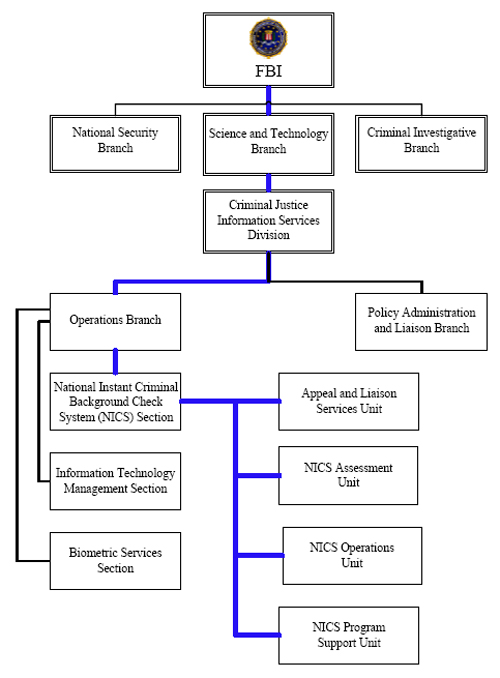2007 Operations Report
2007 Operations Report
FBI Mission
The mission of the FBI is to protect and defend the United States against terrorist and foreign intelligence threats, to uphold and enforce the criminal laws of the United States, and to provide leadership and criminal justice services to federal, state, municipal, and international agencies and partners.
Science and Technology Branch Mission
The mission of the Science and Technology Branch is to facilitate the execution of the FBI’s mission by applying innovative scientific, engineering, and technical solutions to support investigative and intelligence requirements. This is accomplished through the identification, creation, adaptation, and application of state-of-the-art tools and techniques supporting data and evidence collection and analysis, as well as law enforcement services.
Criminal Justice Information Services (CJIS) Division Mission
The mission of the CJIS Division is to reduce terrorist and criminal activities by maximizing the ability to provide timely and relevant criminal justice information to the FBI and to qualified law enforcement, criminal justice, civilian, academic, employment, and licensing agencies concerning individuals, stolen property, criminal organizations and activities, and other law enforcement related data.
National Instant Criminal Background Check System (NICS) Mission
To ensure national security and public safety by providing the timely determination of a person’s eligibility to possess firearms or explosives in accordance with federal law.
Since the implementation of the NICS on November 30, 1998, the FBI has continued to focus on identifying, developing, and implementing process and system improvements to the nation’s firearms background check system. In support of its mission to provide the timely determination of a person’s eligibility to receive firearms or explosives in accordance with federal and state law, the FBI CJIS Division’s NICS Section strives to provide effective and efficient service to its users. The staff and management of the NICS Section take great pride in the many accomplishments achieved program-to-date1 (PTD), in the furtherance of public safety and national security in America. Highlights of the NICS 2007 operations include the following:
- From the inception of the NICS on November 30, 1998, to December 31, 2007, a total of 83,274,985 transactions have been processed through the NICS. Of these, 42,345,756 transactions were processed by the NICS Section at the FBI, and 40,929,229 transactions were processed by the Point-of-Contact states.
- From November 30, 1998, through year-end 2007, the NICS Section denied a total of 610,180 firearm transactions. Of these, the NICS Section rendered 66,817 denial determinations in 2007. The NICS Section’s 1.30 percent denial rate for 2007 remains consistent with the 2006 denial rate of 1.33 percent and the PTD denial rate of 1.44 percent.
- On April 5, 2007, the 75 millionth background check was submitted to the NICS.
- In October 2007, the NICS Index exceeded five million records. As of December 31, 2007, the NICS Index maintained 5,108,039 federally prohibiting records.
- In 2007, the NICS Section processed 62,791 explosives transactions. Of these, a total of 1,669 (or approximately 2.7 percent) resulted in deny determinations.
- In 2007, the NICS Section processed 200,397 transactions via its Internet-based electronic check functionality representing an overall 18 percent increase over the number of NICS Electronic-Check (NICS E-Check) transactions processed in 2006.
- In 2007, the NICS Section achieved a 91.60 percent Immediate Determination Rate (IDR), surpassing the U.S. Attorney General-mandated goal of 90 percent or better, and remained consistent with the 91.58 percent IDR achieved in 2006.
- In 2007, the staff of the NICS Section located and obtained approximately 37,350 final dispositions for posting to criminal history records, and disseminated approximately 14,685 dispositions to state agencies for maintenance at the state level. The staff of the NICS Section has obtained and shared over 630,000 dispositions for posting to criminal history records PTD.
- As of December 31, 2007, there were 6,178 successful entries maintained in the Voluntary Appeal File (VAF). In 2007, a total of 4,272 successful VAF transactions were conducted. The VAF permits the NICS Section to maintain specific information about non-prohibited persons, with their permission, to assist in defining their eligibility to receive firearms.
- In 2007, the NICS Section achieved an overall system availability average of approximately 99.92 percent, surpassing the approximate 99.58 percent availability average for 2006.
- In 2007, a total of 3,055 firearm retrieval referrals were forwarded to the Bureau of Alcohol, Tobacco, Firearms and Explosives (ATF) by the NICS Section.
-
In 2007, the NICS Section implemented many processing improvements:
- Several enhancements to the NICS Section appeals process were implemented, such as processing all appeals by the actual date received (versus by region); accepting fingerprints rolled by non-law enforcement agencies (with certain stipulations); the elimination of the requirement to reprocess resubmitted fingerprints; and implementing efficiencies specific to expedited fingerprint comparison services, among others.
- In March 2007, the NICS Section began providing a rejected VAF applicant with a copy of their criminal history record (CHR) when positively matched via fingerprints to a firearms prohibiting CHR. Additionally, the rejected VAF applicant is provided with the contact information of the agency(ies) that submitted the record(s), thus providing the individual with the opportunity to assist with the update or completion of their CHR.
- In 2007, the NICS Section, with the support and assistance of the CJIS Division’s technical staff, implemented several technical improvements:
January 2007:
- NICS Training Server which provides immediate, real-time training opportunities for the staff of the NICS Section.
- NICS Document Server via Windows SharePoint Services. This document management system provides the effective and efficient delivery of document information, e.g., the NICS Standard Operating Procedures, to the NICS Section employees via a centralized source.
- Ready for Callback prompt. When a NICS Section employee contacts a Federal Firearms Licensee (FFL) to provide a deny status for a delayed transaction that is past the three-business-day time limitation, the prompt requires that the employee determine if the firearm has been transferred, thereby allowing for expediency in processing a potential firearm retrieval referral to the ATF.
- To make available complete information to the NICS’ users specific to all protection orders via the National Crime Information Center (NCIC), the NICS was modified to automatically conduct a query of all protection orders in lieu of manually conducting a secondary search for these records.
April 2007:
- An Immigration Alien Response indicator which alerts the NICS Section staff that search requests for non-U.S. citizens attempting to purchase firearms via the Department of Homeland Security’s U.S. Immigration and Customs Enforcement was made available.
- To hasten the transaction status notification process, the NICS was modified to display a listing of all finalized transactions for the FFL being serviced by a NICS Section employee.
- The NICS was modified to capture the driver’s license number of the subject of a federally prohibiting NICS Index record, thereby allowing background check processing personnel to more effectively determine if a prospective firearms transferee is a valid match to the subject of a NICS Index record.
July 2007:
- To ensure all NICS Section-denied transactions are forwarded to the ATF on a daily basis, a prompt requiring a NICS Section employee to denote the specific record predicating the denial status was deployed.
- The NICS was modified to forward updated transaction comments on denied transactions to the ATF on a daily basis. Complete denial information assists the ATF in determining if prosecution or a firearm retrieval will be pursued.
October 2007:
-
The NICS Database Modernization project was deployed. The project provides the NICS Section employees with:
- the capability to access records maintained in the NCIC and conduct an Interstate Identification Index (III) subject search query;
- enhanced facsimile services;
- identification record report query capability via the employee’s desktop;
- the implementation of (1) a feature that prompts the automatic search of the information maintained in the ATF Relief from Disabilities Database and the NICS Disposition Document File when the NICS returns a valid match to an NCIC or a III record, and (2) a feature that prompts the automatic search of the information maintained in the VAF when the FFL provides an active VAF unique personal identification number (UPIN) to the NICS Section staff. Previously, these databases were maintained separately and required the NICS Section employees to conduct time-consuming manual searches for available information.
- The FFLs were provided with the capability to initiate VAF background check searches via the NICS E-Check process by entering an active VAF UPIN.
1 From November 30, 1998 through December 31, 2007.
Table of Contents
Science and Technology Branch Mission
Criminal Justice Information Services (CJIS) Division Mission
Background of the National Instant Criminal Background Check System (NICS)
NICS Transactions
NICS Participation
NICS Activity
Explosives Background Checks
NICS E-Check Transactions
NICS Denials
Firearm Retrieval Referrals
NICS Appeals
Voluntary Appeal File (VAF)
Performance of the NICS
NICS Availability
NICS Section Immediate Determination Rate (IDR)
NICS Section Average Answer Speed
NICS Section Abandonment Rate
Enhancing the NICS
NICS Training Server
NICS Document Server via Windows SharePoint Services (WSS)
Record Request Confirmation
Ready for Callback (RFC) Prompt
Automatic Query NICS Protection Order (QNP) Search Conducted in Response to a Query NICS (QN) Search Request
NICS E-Check Capability to Allow FFLs to Save Data to File
NICS E-Check Digital Certificate Application Process Streamlined
Immigration Alien Response Indicator
Automatic Display of all Available RFC Transactions for an FFL
NICS Index Capability to Collect and Display a Driver’s License Number
Automatic Notification of NICS E-Check Transactions With a Deny Status Remaining in Queue after Three Business Days
Denying Record Request Prompt
Transmission of Updated Comments on Denied Transactions to the ATF
Search Request Details Updated to the NICS E-Check
NICS Graphical User Interface (GUI) Redesign
NICS Database Modernization
VAF Transaction Processing via the NICS E-Check
NICS Section Capability to Effect Status Changes on Appealed State-Initiated Transactions
NICS Index
NICS Index Focus - Mental Health Prohibitor
Availability of Federally Prohibiting Information Benefits All
NICS Improvement Amendments Act of 2007
NICS Section Outreach
Criminal History Dispositions
Misdemeanor Crime of Domestic Violence (MCDV) Processing
FBI’s Major Case Contact Center (MC3)
Background of the National Instant Criminal Background Check System (NICS)
With the passage of the Gun Control Act of 1968 (GCA), certain persons, such as convicted felons, are prohibited from possessing firearms pursuant to federal law. To strengthen the federal firearms regulations, the Brady Handgun Violence Prevention Act of 1993 (Brady Act), Public Law 103-159, required the U.S. Attorney General to establish the NICS for Federal Firearms Licensees (FFLs) to contact by telephone, or other electronic means, for information to be supplied immediately as to whether the transfer of a firearm would be in violation of Section 922 (g) or (n) of Title 18, United States Code (U.S.C.) or state law.
Through a cooperative effort with the Bureau of Alcohol, Tobacco, Firearms and Explosives (ATF); the Department of Justice (DOJ); and local and state law enforcement agencies, the FBI developed the NICS. On November 30, 1998, the NICS, designed to immediately respond to background check inquiries for prospective firearm transferees, was implemented.
 |
For an FFL to initiate a NICS check, the prospective firearms transferee must complete and sign an ATF Form 4473, Firearms Transaction Record. The ATF Form 4473, which collects the subject’s name and descriptive data (e.g., date of birth, sex, race, state of residence, country of citizenship), elicits information that may immediately indicate to an FFL that the subject is a prohibited person, thereby negating the need to continue the background check.
When an FFL initiates a NICS background check, a name and descriptor search is conducted to identify any matching records in the following nationally-held databases managed by the FBI’s Criminal Justice Information Services (CJIS) Division:
- Interstate Identification Index (III): The III maintains subject criminal history records. As of December 31, 2007, the III records accessed by the NICS during a background check numbered 51,153,117.
- National Crime Information Center (NCIC): The NCIC contains data on persons who are the subject of protection orders, or active criminal warrants, among others. As of December 31, 2007, the NCIC records searched by the NICS during a background check numbered 3,812,723.
- NICS Index: The NICS Index, a database created specifically for the NICS, collects and maintains information contributed by tribal, local, state, and federal agencies pertaining to persons who are federally prohibited from the transfer of a firearm. Typically, the records maintained in the NICS Index are not available via the III or the NCIC. As of December 31, 2007, the NICS Index records searched by the NICS during a background check numbered 5,108,039.
Additionally, a fourth search via the applicable databases of the Department of Homeland Security’s U.S. Immigration and Customs Enforcement (ICE) may be conducted. In response to a mandate issued by the U.S. Attorney General in February 2002, a search of the databases must be conducted on all non-U.S. citizens attempting to receive firearms in the United States. In 2007, the NICS Section and the Point-of-Contact (POC) states2 requested 31,189 such queries of the ICE.
In the majority of cases, the results of a background check yield definitive information regarding subject eligibility within seconds to minutes of the data entry of a prospective firearm transferee’s descriptive information into the NICS. However, not all inquiries can be provided a final status within the scope of the FFL’s initial contact with the NICS. Accordingly, some inquiries are delayed due to missing or incomplete information needed to make a determination as to whether a firearm transfer may be proceeded or must be denied. Under federal law, an arrest record alone cannot preclude the transfer of a firearm unless state law provides otherwise.
In instances where a valid matching record discloses “potentially” disqualifying record information, such as a felony offense arrest or a possible misdemeanor crime of domestic violence, etc., that is not complete, the NICS Section or the POC state agency processing the transaction must search for the information needed to complete the record. This process often requires outreach to tribal, local, state, and/or federal agencies (e.g., arresting agencies, court systems, etc.). The Brady Act includes a provision to allow for three business days to conduct research in order to locate and obtain additional information. If the information is not obtained within the three-business-day time frame and a final transaction status cannot be rendered, the FFL has the option to legally transfer the firearm.
Individuals who believe they are wrongfully denied the transfer of a firearm based on a record matched during a NICS background check can appeal the deny decision. The “denying agency” will be either the NICS Section or the state agency serving as a POC for the NICS. In the event the denying agency is a POC state agency, the appellant can, in the alternative, elect to appeal to the FBI. The provisions for appeals are outlined by the NICS Regulations at Title 28, Code of Federal Regulations (C.F.R.), Part 25.10, and Subsection 103(f) and (g), and Section 104 of the Brady Act.
The Safe Explosives Act requires that persons who export, ship, cause to be transported, or receive explosives material in either intrastate or interstate commerce must first obtain a federal permit or license after undergoing a NICS background check. Enacted in November 2002 as part of the Homeland Security Act, the Safe Explosives Act became effective on May 24, 2003. Background checks for explosives permits are processed by the NICS Section.
Extensive measures are taken to ensure the security and the integrity of NICS information. Access to the data in the NICS is restricted to agencies authorized by the FBI under DOJ regulations. The U.S. Attorney General’s regulations regarding the privacy and security of the NICS is available on the Internet at www.fbi.gov/hq/cjisd/nics/index.htm.
2 Those states that have implemented and maintain a state-operated NICS program.
 |
Every successful organization is dependent on the ability of its leadership to identify the direction the organization will follow in order to accomplish its overall purpose or mission; however, identifying what is needed to accomplish immediate business needs and requirements is not enough. To ensure long-term growth and the continued success of the NICS program, the leaders of the NICS Section, in collaboration with the leaders of the CJIS Division, espouse the fundamentals of strategic management.
Strategic or tactical planning, an ongoing process that allows management to continually identify, implement, and evaluate business decisions designed to promote the achievement of both short-term and long-term results in the pursuit of success, has proven to be an effective management tool in the NICS Section. With the realization that the pace of societal and technological change is swift, the need to plan for the future, such as through strategic planning efforts, cannot be overstated. Accordingly, the NICS Section’s management focuses on comprehensive planning initiatives which, in turn, provide consistent direction to the staff regarding where the NICS Section is going and how it will get there. Those efforts and resulting achievements pinpoint opportunities to further enhance business continuity, to strengthen partnerships with users, and to provide the optimal level of customer service for which the FBI, and the NICS Section, is known.
With a continual focus on identifying business needs that invariably create a more effective and efficient background check program, the NICS Section targeted four specific goals as the foundation for its Fiscal Year 2007 Tactical Plan. The goals pursued by the NICS Section in 2007 are summarized as follows:
-
Provide Excellent Customer Service: The NICS Section continually seeks to improve its processing regimen in pursuance of providing timely, consistent, and quality service. Because changes in everyday work processing continually occur and must be addressed, it is necessary that upgrades and improvements to the existing NICS work environment be quickly identified, developed, and deployed.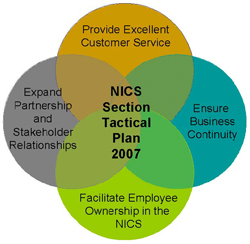
- In April 2007, one of the many measures implemented by the NICS Section in pursuit of excellent customer service was the deployment of the “team concept” for the facilitation of the NICS Section’s Standard Operating Procedures (SOPs). Prior to April 2007, the NICS SOPs were facilitated by one all-inclusive group of employees with diverse job duties and responsibilities. Because of the diversity of the employees staffing the procedure review mechanism, there existed the potential that limited knowledge of the specific process under review by team members who typically do not facilitate a specific procedure contributed to a lengthy and cumbersome process. However, under the new SOP “team concept,” the NICS SOPs are more expeditiously maintained via the establishment of numerous smaller teams each serving in a subject-matter-expert (SME) capacity specific to a particular facet of NICS processing. By focusing on the knowledge of SMEs to more effectively and efficiently maintain the NICS SOPs, the implementation of the SOP “team concept” enhanced the NICS Section’s capability to more effectively process work in a continual, current, and consistent manner. As a result, the existing backlog of procedures awaiting review and revision was expeditiously eliminated. This provided all NICS Section employees with the capability to process work in an accurate and consistent manner, thus ensuring a high level of continued customer service.
- Expand Partnership and Stakeholder Relationships: To enhance and strengthen connections with external agencies championing a vested interest in the success of the NICS, the NICS Section facilitated numerous initiatives to strengthen relationships with key partners, such as the ATF. One such initiative was achieved in July 2007 when the NICS was modified to automatically forward updated background check information on denied transactions to the ATF with the nightly batch transfer. Complete information assists the ATF with rendering more effective decisions specific to potential firearm retrievals and prosecutorial actions. Accordingly, the nightly submission of the additional denial transaction data helps the ATF with prioritization of workload duties and responsibilities. Throughout 2007, the NICS Section also strengthened its relationship with the ATF via efforts to reduce inefficiencies both internal and external to the NICS Section regarding potential firearm retrieval referrals. As a result, the NICS Section enhanced the firearm retrieval referral notification process by eliminating unnecessary paperwork and by implementing a more efficient method of disseminating the firearm retrieval referral information to the ATF.
- Facilitate Employee Ownership in the Success of the NICS: The management of the NICS Section supports the ideology that the continual identification of improvements in pursuit of optimal effectiveness and efficiency of the NICS is the responsibility of all employees, thus they promote employee ownership in the success of the NICS. With an objective engineered toward performance-based management, the NICS Section established the NICS Section Quality Policy. The NICS Section’s Quality Policy commands that all employees work continuously to achieve and surpass existing levels of high quality in performance that, in turn, lead to a more effective and efficient, hence a successful background check program. The NICS Section’s Quality Policy focuses key business interests, such as customer satisfaction, quality assurance, training, and communication, among others.
- Ensure Business Continuity: To ensure the availability of the NICS to its users during catastrophic incidents as well as during planned and unplanned system downtime, the NICS Section reinforced its commitment to preparedness via the comprehensive update to the NICS Section’s Contingency Plans. Accordingly, in early 2007, the NICS Section’s Contracted Call Center Contingency Plan was updated. Although periodic testing measures are facilitated by the NICS Section to ensure overall contingency effectiveness, a natural weather-related occurrence provided the NICS Section with an opportunity to test contingency measures in real time. On April 3, 2007, a tornado warning was received at one of the NICS Section’s Contracted Call Centers. The warning was followed by a power outage. Based on the swift implementation of effective measures designed to ensure the continuity of NICS operations as delineated in the NICS Section’s revised Call Center Contingency Plan, all NICS service levels were successfully maintained.
Not unlike many organizations, the NICS Section tracked the progress and success of various program components through the use of a balanced scorecard (reference Figure 1).
Figure 1
Sample, NICS Section’s Balanced Scorecard
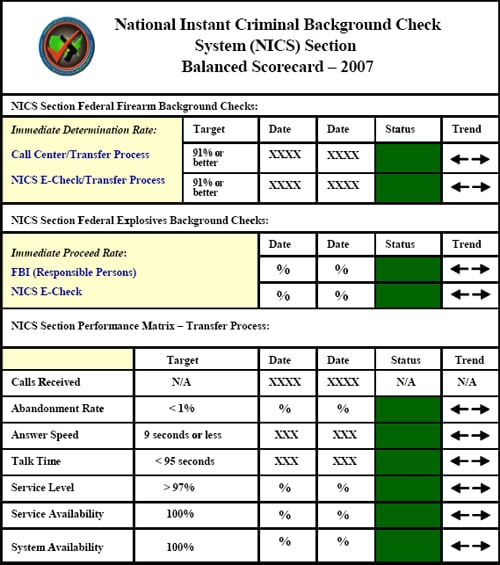 |
The NICS Section’s Balanced Scorecard captured and made readily available various detailed facets of current and past business activities that, at a glance, allowed management to make logical assumptions and decisions, oftentimes at a moment’s notice, which in turn, balanced organizational performance against targeted goals and objectives.
From November 30, 1998, to December 31, 2007, a total of 83,274,985 transactions were processed through the NICS. Of these, a total of 40,929,229 transactions were processed by the states that have implemented and maintain a state-operated NICS program (as determined by each state government). The remaining 42,345,756 transactions were processed by the NICS Section at the FBI’s CJIS Division located in Clarksburg, West Virginia (reference Figure 2).
The Brady Act prohibits an FFL from transferring a firearm until the FFL has submitted the prospective transferee’s name and descriptive information to the NICS and has either received a definitive proceed or deny response, or three business days have elapsed absent a final determination from the NICS.
Figure 2
NICS Transactions - November 30, 1998, through December 31, 2007
|
|
Federal |
State |
Total |
|
PTD Total |
|---|---|---|---|---|---|
| 1998 |
506,554 |
386,286 |
892,840 |
|
892,840 |
|
1999 |
4,538,020 |
4,600,103 |
9,138,123 |
|
10,030,963 |
|
2000 |
4,260,270 |
4,282,767 |
8,543,037 |
|
18,574,000 |
|
2001 |
4,291,926 |
4,618,265 |
8,910,191 |
|
27,484,191 |
|
2002 |
4,248,893 |
4,205,429 |
8,454,322 |
|
35,938,513 |
|
2003 |
4,462,801 |
4,018,787 |
8,481,588 |
|
44,420,101 |
|
2004 |
4,685,018 |
4,002,653 |
8,687,671 |
|
53,107,772 |
|
2005 |
4,952,639 |
4,000,306 |
8,952,945 |
|
62,060,717 |
|
2006 |
5,262,752 |
4,774,181 |
10,036,933 |
|
72,097,650 |
|
2007 |
5,136,883 |
6,040,452 |
11,177,335 |
|
83,274,985 |
|
Total |
42,345,756 |
40,929,229 |
83,274,985 |
|
|
NICS Participation
In those states that have elected to participate with the NICS by maintaining a state-operated NICS program, the states’ FFLs initiate background checks for their customers by contacting the state-designated POC agency. In the states that have declined participation with the NICS, the states’ FFLs contact the NICS Section, via one of two Contracted Call Centers or the NICS Electronic-Check (NICS E-Check), to initiate the required background checks.
As of December 31, 2007, the NICS Section provided service to 29 states, five U.S. territories, and one district, while 13 states had agencies acting on behalf of the NICS by providing full service to the states’ FFLs. Certain states, such as those that already had an existing handgun purchase program in place prior to the deployment of the NICS, elected to participate with the NICS on a partial basis by processing NICS background checks specific to handguns or handgun permits while the NICS Section processes the long gun transactions for the states’ FFLs. As of December 31, 2007, there were eight states participating with the NICS in a Partial-POC capacity. The NICS Participation Map (reference Figure 3) displays each state’s participation with the NICS as of December 31, 2007.
Figure 3
NICS Participation Map as of December 31, 2007
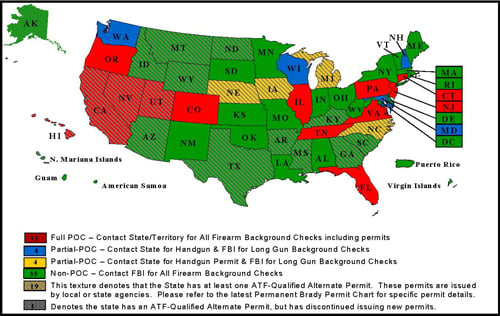 |
NICS Activity
The demand placed upon the NICS typically parallels the retail market. As state hunting seasons and yearend holidays approach, the rate of background check submissions to the NICS progressively increases. To help manage the progressive increases in NICS operational activity, the NICS Section typically extends the normal operational hours of the NICS to accommodate transactions submitted to the FBI and to the POC states. Accordingly, on November 1, 2007, and through January 11, 2008, a deviation from the normal operating hours of 8 a.m. to 1:00 a.m. to the temporary operating hours of 6:30/7:00 a.m. (for the NICS Section and the POC states respectively) to 1:30 a.m. was implemented. The expanded NICS availability not only provides the NICS Section and the POC/Partial-POC states with opportunities to conduct research and record reviews often required when processing background check transactions but also helps to deter potential bottlenecks in transactional activity in support of the efficient processing of incoming work.
Explosives Background Checks
The Safe Explosives Act, enacted as part of the Homeland Security Act in November 2002, requires that any person who transports, ships, causes to be transported, or receives explosives materials in either interstate or intrastate commerce must (1) obtain a federal permit/license issued by the ATF and (2) undergo a NICS background check. The Safe Explosives Act categorizes applicants as either “Responsible Persons” (persons who have the power to direct the management and policies pertaining to explosives materials) or “Employee Possessors” (employees authorized by the applicant to possess explosives materials, e.g., someone who has actual physical possession or direct control over the explosives materials).
Since the processing of the first explosives background check by the NICS Section in February 2003, the NICS Section, through December 31, 2007, has processed a total of 249,487 explosives background checks. Of these, a total of 62,791 explosives transactions were processed by the NICS Section in 2007 (reference Figure 4). Of the explosives transactions processed by the NICS Section in 2007, a total of 5,057 transactions were specific to the Responsible Persons category while 57,734 transactions were for Employee Possessors. In 2007, a total of 1,660 explosives transactions (or 2.64 percent) were denied.
Figure 4
Explosives Transactions Processed by the NICS Section, 2005 - 2007
 |
NICS E-Check Transactions
As an alternative to initiating a NICS background check telephonically, the NICS E-Check was deployed in August 2002. The NICS E-Check enables FFLs to initiate unassisted background check searches through the NICS via the Internet. The use of the NICS E-Check has created many process efficiencies for the NICS Section and the NICS’ users, such as (1) allowing an FFL’s direct data entry of subject search information into the system to ensure the accuracy of the data; (2) the capability for an FFL to retrieve background check results 24/7 (including the results of transactions implemented via the telephone); (3) alternate transaction initiation for the hearing and speech impaired; (4) the capability to print completed NICS background check search requests for record-keeping purposes; (5) the capability for FFLs to receive e-mail notifications from the NICS Section; and others. Equally important, the use of the NICS E-Check helps to reduce NICS Section Contracted Call Center traffic and, thus, contractor costs. As the use of the NICS E-Check grows, the chances of potential bottlenecks in call center traffic, such as could occur during the NICS Busy Season or in the event of unanticipated spikes in business, are minimized.
From the implementation of the NICS E-Check through December 31, 2007, there have been 594,057 firearm background check transactions processed through the NICS Internet access capability. Of the firearm transactions processed through the NICS E-Check, a total of 200,397 background checks, equating to an increase of approximately 18 percent over the 2006 tally, were conducted in 2007 (reference Figure 5). As of December 31, 2007, there were approximately 2,000 active FFLs utilizing the NICS E-Check.
Figure 5
Growth of the NICS E-Check through December 31, 2007
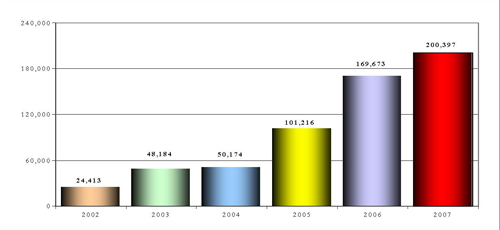 |
NICS Denials
Pursuant to the Brady Act, FFLs are required to contact the NICS for information to be supplied immediately as to whether the transfer of a firearm would violate federal or state law. A deny decision from the NICS indicates that the name and descriptive information of the prospective firearms transferee was matched to the name and descriptive information of the subject of a record containing either federally prohibiting criteria or state prohibiting criteria. The federally prohibiting criteria, pursuant to Title 18, U.S.C., Section 922 (g) and (n), follows:
- Persons who have been convicted in any court of a crime punishable by imprisonment for a term exceeding one year, or any state offense classified by the state as a misdemeanor and punishable by a term of imprisonment of more than two years;
- Persons who are under indictment or information for a crime punishable by imprisonment for a term exceeding one year;
- Persons who are fugitives from justice (e.g., the subject of an active criminal warrant);
- Persons who are unlawful users of or are addicted to any controlled substance;
- Persons who have been adjudicated as mental defectives or have been involuntarily committed to any mental institution;
- Persons who are aliens and are illegally/unlawfully in the United States;
- Persons who have been discharged from the armed forces under dishonorable conditions;
- Persons who, having been citizens of the United States, have renounced their U.S. citizenship;
- Persons subject to a court order that restrains them from harassing, stalking, or threatening an intimate partner or child of such intimate partner, or from engaging in other conduct that would place the partner or child in reasonable fear of bodily injury; and
- Persons convicted in any court of a misdemeanor crime of domestic violence.
The NICS Section can, with certainty, generate statistics specific to the number of background checks implemented with the NICS by both the FBI and the POC/Partial-POC states as all firearms background checks must pass through the NICS. However, not all final transaction statuses are reported to the NICS by the POC/Partial-POC states; therefore, state final determinations are not included in this report since the total would not be all inclusive.3 Since the implementation of the NICS on November 30, 1998, and through December 31, 2007, a total of 610,180 transactions have been denied by the NICS Section (reference Figure 6).
Figure 6
NICS Section Denials - PTD through December 31, 2007
| Year | Number of Transactions Conducted | Number of Denials Rendered | Denial Rate Percentage |
|---|---|---|---|
| 1998-1999 | 5,044,574 | 89,836 | 1.78 |
| 2000 | 4,260,270 | 66,808 | 1.57 |
| 2001 | 4,291,926 | 64,500 | 1.50 |
| 2002 | 4,248,893 | 60,739 | 1.43 |
| 2003 | 4,462,801 | 61,170 | 1.37 |
| 2004 | 4,685,018 | 63,675 | 1.36 |
| 2005 | 4,952,639 | 66,705 | 1.35 |
| 2006 | 5,262,752 | 69,930 | 1.33 |
| 2007 | 5,136,883 | 66,817 | 1.30 |
| Total | 42,345,756 | 610,180 | 1.44 |
When a NICS Legal Instruments Examiner (NICS Examiner) renders a transaction denial determination, a code indicating the specific reason or basis for the denial is entered into the NICS. This tracking mechanism allows the NICS Section to maintain and generate statistics regarding the specific prohibiting reasons upon which transaction denials are predicated. From program inception in November 1998 through December 31, 2007, the leading reason for NICS Section denials is based on the valid match of a prospective firearm transferee’s name and descriptive information to the subject of a prohibiting criminal history record (reference Figure 7).
Figure 7
Reasons Why the NICS Section Denies - November 30 1998 through December 31, 2007
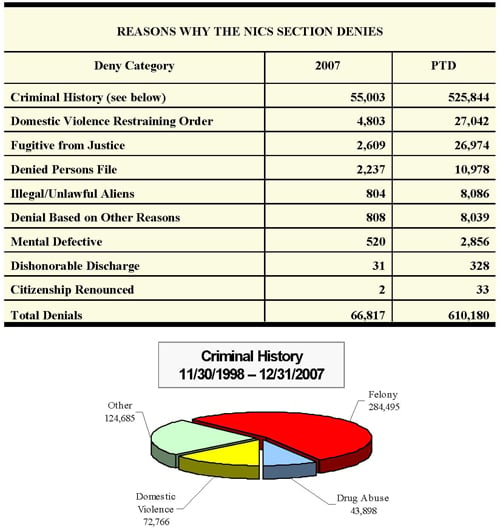 |
Firearm Retrieval Referrals
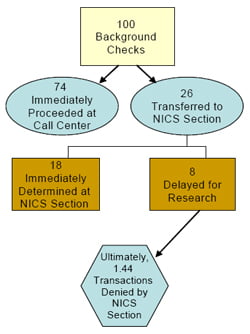 |
Based on the background checks submitted to the NICS by the FFLs serviced by the FBI, approximately 8 out of every 100 NICS background check transactions are delayed because of incomplete records, e.g., missing criminal history dispositions. Since the inception of the system in November 1998, the NICS Section and its state counterparts have been continuously challenged with obstacles encountered when reaching out to local, state, and federal agencies in attempts to obtain record information needed to render accurate transaction determinations. The Brady Act provides the NICS with three business days for this purpose; however, if the needed disposition information is not obtained within that time limitation and a transaction status cannot be determined, the FFL may transfer the firearm. In 2007, over 134,000 transactions processed by the NICS Section did not reach a final status before the lapse of three business days because of incomplete or unavailable record information. As such, the potential that prohibited persons may be in possession of firearms becomes more of a reality; however, to counterbalance, the NICS Section not only continues to actively seek the missing record information beyond the three-business-day time frame, but remains proactive in efforts to enhance criminal history record and disposition reporting.
When the NICS Section receives prohibiting disposition information after the three-business-day time frame and renders a deny decision to the FFL, it is possible that the firearm has already been transferred. These scenarios pose serious public safety risks, as a firearm, in the control of a prohibited person, must be retrieved. Such instances are referred to the ATF. In 2007, the NICS Section staff referred 3,055 such firearm retrieval cases to the ATF.
NICS Appeals
Since the inception of the NICS on November 30, 1998, through December 31, 2007, over 610,000 background check deny decisions were provided by the NICS Section. Over 66,000 of these deny decisions were rendered in Calendar Year 2007. Pursuant to the Brady Act, any individual denied the transfer of a firearm based on a record returned by the NICS can appeal to the “denying agency” for reconsideration of the deny decision by challenging the accuracy or applicability of the record or by asserting that their firearm rights were restored. The provisions for appeals are outlined by the NICS Regulations at Title 28, C.F.R., Part 25.10, and Subsection 103 (f) and (g) of the Brady Act.
In 2007, the NICS Section received 11,890 appeal requests. To support the requests received during 2007, the appellants submitted 7,140 fingerprint cards and approximately 2,300 disposition and/or record-clarifying documents to assist the NICS Section. Approximately 25 percent of the denial decisions rendered by the NICS Section were overturned on appeal. Keeping in mind that the NICS is a name-based check system, the leading reason for the overturned deny decisions in 2007 was based on the appellant’s fingerprints not matching the fingerprints of the subject of a firearms disqualifying record.
To hasten the appeal process, the NICS Section identified and implemented various appeal processing enhancements in 2007. Some of the enhancements to the NICS Section’s appeal process include: (1) the processing of appeals by actual date order received versus by region; (2) the acceptance and processing of fingerprints rolled by non-law enforcement personnel (with certain stipulations); (3) resubmitted fingerprints are no longer subject to time-expending reprocessing (e.g., with subsequent appeals); (4) the implementation of state/region-specific appeal POCs to promote the expeditious processing of appeal requests from persons denied by POC state agencies; and (5) expedited identification processing of appeal-related fingerprint card submissions.
Voluntary Appeal File (VAF)
Because numerous criminal history (and related) records are not complete, accurate, or up-to-date, eligible firearm purchasers may be subject to lengthy delays or transaction deny decisions that are subsequently overturned on appeal. In many instances, record-clarifying information is located and obtained but, for various reasons, cannot be used to update the record predicating the delay or the deny. There are also cases whereby an eligible firearm purchaser’s fingerprints confirm they are not the subject of a prohibiting criminal history record matched by name and descriptive data during a NICS background check. In the latter, the subject’s deny decision may be overturned as the result of a successful appeal; however, oftentimes the process must be repeated when the subject attempts to purchase again.
To assist eligible firearm purchasers who experience lengthy delays or denies, the VAF was implemented in 2004. The VAF is a computer-based file that houses voluntarily provided documentation about eligible firearm purchasers to assist the NICS in justifying the individual’s firearms eligibility status during the background check process. When an applicant is approved for entry into the VAF, he or she is issued a unique personal identification number (UPIN) which can be provided to the NICS during subsequent background checks. The presentation of an active UPIN prompts the review of additional information maintained in the VAF in support of an accurate and timely background check decision.
Prior to March 2007, when an applicant only applied for VAF entry without an appeal and was denied entry into the VAF, they were provided information explicating the specific federal or state prohibitor upon which the rejection was based. Additionally, their application and supporting fingerprint card was returned with the correspondence, along with detailed instructions as to how they may obtain a copy of the prohibiting record. However, in the interest of efficiency, and in the spirit of optimal customer service, the NICS Section, in March 2007, began providing the subject with a copy of their criminal history record (when positively matched by fingerprint comparison) and also provided the individual with contact information for the agency(ies) that provided the record(s) upon which the VAF entry rejection was based. With this information, the individual can pursue correction, update, or clarification of the record(s) used to deny their VAF application.
The implementation of the VAF has assisted many lawful firearm purchasers to receive timely background check determinations. As of December 31, 2007:
- There were 6,178 active UPINs maintained in the VAF.
- A total of 6,180 successful VAF checks had been conducted PTD.
- Of the successful 6,180 VAF checks, a total of 4,272 were conducted in 2007.
3 State denial data can be accessed via the DOJ Bureau of Justice Statistics website.
NICS Availability
Since the implementation of the NICS on November 30, 1998, the NICS Section has continually focused on maintaining a high level of system availability. The FFLs depend on the NICS to be on-line and accessible during its standard operating hours of 8 a.m. to 1 a.m., 364 days a year.4 Based on legal requirements set forth in the NICS Regulations, combined with the high expectations of the NICS’ users, the NICS Section and the CJIS Division have devoted numerous resources, in-house experience, and contractor expertise to deliver timely service to the NICS’ users.
 |
During the background check process, the records housed in the III (a component of the Integrated Automated Fingerprint Identification System [IAFIS]), the NCIC, and the NICS Index, all maintained by the CJIS Division, are simultaneously searched for any records matched by name and descriptors to prospective firearm transferees. The aforementioned CJIS systems searched by the NICS, also known as the CJIS System of Systems (SoS)5, function independently. However, as the results of a “combined” records search comprise the NICS response, their interdependence becomes evident as the loss of service to one the databases could impact the NICS’ ability to gather the information needed to determine a subject’s firearms eligibility status. Therefore, it is possible that although the NICS is available, one of the other systems searched during a background check is not. When this occurs, the NICS Section’s staff works with the CJIS Division technical experts to expeditiously resolve noted issues. For example, on July 12, 2007, at approximately 10:49 a.m., the NICS began receiving partial responses specific to III records. The NICS System Administrators and the CJIS Division’s Information Technology Management Section (ITMS) quickly determined that a power distribution unit failure caused a communication inefficiency with the connection between the III and the NCIC. After implementing immediate measures to resolve the problems detected with the power equipment, the issues causing the NICS to receive partial responses were abated within minutes.
Effective contingency planning by the NICS Section staff also serves to minimize disruptions to NICS service. For instance, on February 11, 2007, maintenance performed by the CJIS Division specific to the NCIC interfered with the ability of the NICS Section’s staff to request system-matched NCIC records via the NICS for review when processing background check transactions. For the short duration of NCIC unavailability, the NICS Section employees requested the necessary NCIC record information via Cyberlynxx, the Web-based NCIC platform. Based on effective contingency planning, the NICS Section was able to minimize temporary background check processing inefficiencies and thus continue service availability to its users.
Based on effective information technology planning specific to the CJIS SoS, in 2007, the availability of the NICS maintained a monthly service availability of approximately 99.70 percent or better (reference Figure 8) and, on average, was available approximately 99.92 percent of the time. When compared to the availability average of 99.63 in 2005 and 99.58 in 2006, it is evident that the NICS Section and the CJIS Division are committed to providing a high level of service availability to its users.
Figure 8
NICS Availability 2005-2007
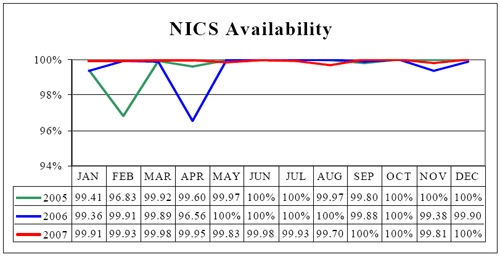 |
NICS Section Immediate Determination Rate (IDR)
The FFLs serviced by the FBI contact the NICS, via one of two NICS Contracted Call Centers, for information to be supplied immediately as to whether the transfer of a firearm would violate federal or state law. If the background check search, initiated at the NICS Contracted Call Center, yields no record matches, the transaction is approved, and the call center staff advises the FFL accordingly. The transactions immediately approved at the call center level support the NICS Immediate Proceed Rate. However, if any matches are returned in response to a background check search, the call center staff transfers the FFL’s call directly to the NICS Section for a speedy records review in an attempt to determine subject eligibility while the FFL is still on the telephone, hereafter referred to as the Transfer Process. The proceed and deny responses provided to an FFL by the NICS Section during the Transfer Process, when combined with the immediate proceed responses provided by the NICS Contracted Call Center staff, comprise the NICS Section IDR. In 2007, the NICS Section IDR average remained steady at approximately 91.60 percent (reference Figure 9), thereby continuing to surpass the 2002 Attorney General’s directive requiring the NICS Section to maintain a 90 percent or better rate of immediate transaction determinations.
Figure 9
NICS Section Immediate Determination Rate 2005 - 2007
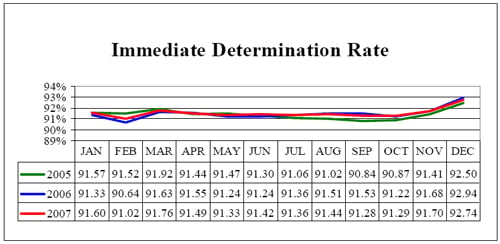 |
NICS Section Average Answer Speed
Industry standards for many types of call center-based operations target the average amount of time that a caller waits before their call is answered at approximately “80 percent of all calls being answered within 20 seconds.” However, the NICS Section, with a constant focus on customer service, continually strives to surpass comparable industry standards. Based on this perspective, in 2007, the NICS Section continued its historically established internal goal of answering allnine seconds. In 2007, the NICS Section answer speed averaged at all calls being answered in approximately 7.78 seconds (reference Figure 10).
Figure 10
NICS Section Average Answer Speed, 2005-2007
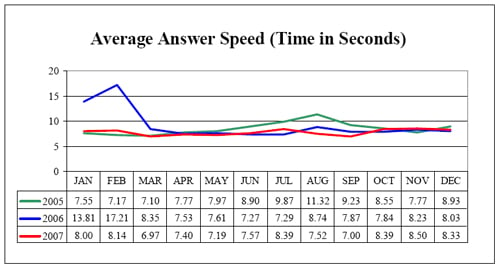 |
NICS Section Abandonment Rate
As with any type of call center operation, there are calls that for a variety of reasons are abandoned by the caller before the call is answered. Caller tolerance levels are subject to variable factors, many of which are specific to the caller’s atmosphere and thus not within the control of the party contacted. However, to compensate, the NICS Section endeavors to continually identify and implement system and procedural changes that move the Section towards more efficient service in addition to a quality product. In 2007, the NICS Section surpassed its target rate of containing the level of abandoned calls to less than 1 percent of all calls. Accordingly, the NICS Section Abandonment Rate (reference Figure 11), in 2007, averaged at approximately 0.38 percent.
Figure 11
NICS Section Abandonment Rate 2005-2007
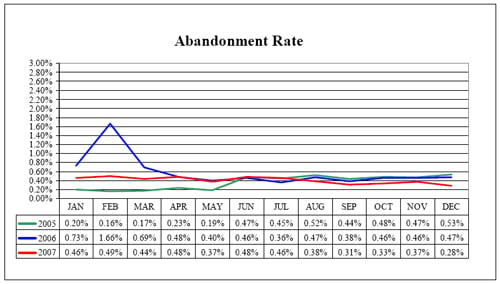 |
4The NICS is not available on December 25.
5 The CJIS SoS is comprised of the NICS, the NCIC, and the IAFIS.
The recognition of procedural or technological improvement to the NICS can occur at any time and is proffered from a variety of sources such as by Congressional or DOJ mandates, via the staff and/or management of the NICS Section, or from POC state officials. Because any change or improvement has the propensity to create different impacts for various users, the NICS Section strives to enhance and strengthen its relationships with its partners in direct support of its goals and objectives. With this philosophy in mind, the NICS Section, with assistance from the CJIS Division’s technical staff, developed and implemented many improvements to the NICS in 2007. Some of those NICS improvements include:
January 2007:
- NICS Training Server: In addition to providing the tools necessary to perform mission critical and various other duties and responsibilities specific to processing background check transactions, the NICS Section is proactive in promoting its staff’s preparedness via simulated training opportunities. With the implementation of the NICS Training Server, new employees are provided the opportunity to experience the processing of NICS transactions via a system-generated, simulated training environment. Also, when technological improvements are scheduled for implementation, all NICS Section employees are provided opportunities to learn and function in the new environment prior to deployment. With the installation of nonoperating system simulators for communicating with databases searched during the background check process, various processing scenarios are available as learning activities in pursuit of an optimally results-oriented workplace.
- NICS Document Server via Windows SharePoint Services (WSS): The WSS provides a document management system for the NICS Section. The WSS offers centralized storage with a single point of access and single sign-on. Providing the NICS Section with the capability to target information for specific audiences by permitting the customization and personalization of content and layout, in addition to various document management capabilities, the WSS was deployed.
- Record Request Confirmation: Automation that prompts a message confirmation specific to the successful dissemination of a facsimile request for record-clarifying information to the intended recipient (e.g., external court system) was deployed. This improvement promotes efficiency in the NICS Section by eliminating the need for a NICS Section employee to expend time manually denoting the dissemination of requests for record information.
- Ready For Callback (RFC) Prompt: If an FFL cannot be contacted at the time when the status of a delayed transaction is determined, the transaction is placed in the RFC queue. Deployment of the RFC prompt reminds a NICS Section employee when notifying an FFL of a deny determination for a transaction older than three business days to determine if the firearm was transferred. This enhancement provides efficiency when performing callback duties and increases expediency when a potential firearm retrieval may be required.
- Automatic Query NICS Protection Order (QNP) Search Conducted in Response to a Query NICS (QN) Search Request: Included with protection order ( PO) information in the NCIC is the Brady Indicator. Denoting the Brady Indicator field allows a state to indicate if the PO triggers a firearms prohibition. Historically, CJIS Division audits have detected ongoing inaccuracies specific to the Brady Indicator field. Because of the inaccuracies associated with incorrectly denoted Brady Indicators, a prohibited person could conceivably receive a firearm as not all POs are returned via the QN functionality. The return of all available POs to the user during a background check increases accuracy when determining background check statuses. Accordingly, the NICS was modified to automatically conduct a QNP search of the NCIC during a background check regardless of the type of query requested.
- NICS E-Check Capability to Allow FFLs to Save Data to File: The capability for the FFLs to save a soft copy text file of transaction history search information initiated via the NICS E-Check specific to their customers was deployed. This functionality allows an FFL to capture and store customer-specific data in various formats conducive to their business purposes, e.g., record keeping and tracking, formulation of statistics, etc.
- NICS E-Check Digital Certificate Application Process Streamlined: To increase efficiencies in access to the NICS E-Check by the FFLs, an enhancement to reduce the time required to process a new or renewal NICS E-Check digital certificate was deployed.
April 2007:
- Immigration Alien Response Indicator: When a search of the databases of the U.S. Immigration and Customs Enforcement has been completed and returned to the NICS, the requesting NICS Section employee is notified of the record return via a desktop response queue light. This enhancement provides efficiencies in processing and determining timely background check determinations.
- Automatic Display of all Available RFC Transactions for an FFL: When a final status is determined for a delayed background check transaction and if the FFL cannot be contacted at that time, the transaction is placed in the RFC queue. Daily, the NICS Section employees facilitate calls to FFLs to provide the final statuses of the RFC transactions. In an effort to reduce “back-end” processing, all available RFC transactions for the FFL are displayed and the statuses provided to the FFL. This improvement minimizes the number of outgoing calls, creates efficiencies for the user, and enhances customer service by enabling a more timely notification of transaction statuses to the FFLs.
- NICS Index Capability to Collect and Display a Driver’s License Number: To assist with determining the valid match of a prospective firearm transferee’s name and descriptive information to the name and descriptive information of a NICS Index record, the record holder’s Driver’s License number can be captured and displayed in a NICS Index record.
July 2007:
- Automatic Notification of NICS E-Check Transactions With a Deny Status Remaining in Queue After Three Business Days: All NICS E-Check transactions not retrieved by the FFL via the NICS E-Check are automatically placed in the RFC queue after the third business day. Placement in the RFC queue prompts the NICS Section to contact the FFL by phone to provide the transaction status, to determine if the firearm transferred, and if a firearm retrieval should be referred to the ATF. This enhancement minimizes the potential of firearm possession by prohibited persons.
- Denying Record Request Prompt: When a background check transaction is denied by the NICS Section, the record predicating the transaction’s deny status (e.g., III record, NICS Index record) is “selected” by the NICS Section employee processing the transaction and captured in the NICS. On a nightly basis, all NICS Section denied transactions are forwarded to the ATF for their review. If a transaction’s deny-predicating record was not “selected,” complete information specific to the transaction and resulting deny status is not available to the ATF. In the spirit of partnership and to ensure that complete denial transaction information is available for review by the ATF, the NICS Section employees are now required, via a system prompt, to “select” the specific denying record prior to finalizing the transaction.
- Transmission of Updated Comments on Denied Transactions to the ATF: All denied transactions are forwarded to the ATF daily. In many instances, subsequent action, such as the receipt of additional information, occurs after a denial notification transmission. Complete information specific to denial transactions is crucial to ATF efforts. In the furtherance of public safety, this system enhancement prompts the follow-up transmission of updated denied transaction information to the ATF.
- Search Request Details Updated to the NICS E-Check: To provide the FFLs using the NICS E-Check with the capability to track the submission and retrieval of background check inquiries by their staff, the Search Request Detail functionality was deployed to assist the FFLs with the management and tracking of single certificate usage.
- NICS Graphical User Interface (GUI) Redesign: The update of the NICS GUI, a computer interface that allows a user to effectively and efficiently interact with the NICS, was implemented. The development and the implementation of the update, which served to enhance the connectivity between the NICS Toolbar and the NICS Contracted Call Centers, promotes consistency specific to shared data management.
October 2007:
-
NICS Database Modernization: Providing the NICS Section employees with a single point of access to additional tools needed to perform their duties more efficiently and effectively, the final phase of the NICS Personal Computer (PC) Client desktop automation project was completed. As a result, the NICS Section employees are able to access numerous applications in addition to the NICS, such as NCIC query capability, III subject search capability, enhanced facsimile services and e-mail capabilities, identification record report query capability, etc., via their individual workstations. The efficiencies gained with the implementation of the desktop automation project illustrate the NICS Section’s commitment to providing optimal service.
Parallel to the final stages of the deployment of PC Client, the NICS Section, with the CJIS Division’s ITMS, initiated the development of several enhancements to the NICS to provide for the automatic search of:
- ATF Relief from Disabilities Database (ATFRDD): The ATFRDD is a catalogue of records provided by the ATF to the NICS Section which contains information specific to persons granted relief from a federal firearms disability by the ATF.
- Disposition Document File (DDF): The DDF collects and maintains supplemental documentation to support or clarify potentially prohibiting information (e.g., incident reports, police reports, protection order conditions, etc.) that cannot otherwise be posted to or maintained and searched in the III or the NCIC.
- Voluntary Appeal File (VAF): Often, clarifying information that would serve to nullify an otherwise prohibiting record cannot be posted to a record availed during the background check process. The VAF is a database that maintains specific information voluntarily provided by a firearm transferee for use in determining their eligibility to receive firearms associated with subsequent background checks in a more timely manner. (Reference page 13 for additional information specific to the VAF.)
When processing a delayed background check transaction, if the NICS Section employee determines the valid match of a prospective firearm transferee’s name and descriptive information to the name and descriptive information of the subject of an NCIC or a III record, the employee must request the complete record for review and evaluation to determine if any federal or state prohibiting criteria exists. With the deployment of the NICS Database Modernization project, when a NICS Section employee requests the complete NCIC or III record, the NICS will simultaneously and automatically search the ATFRDD and the DDF for any supplementally maintained information that could assist in determining the subject’s firearms eligibility status.
All transactions for individuals possessing an active VAF UPIN must be referred to and processed by the NICS Section staff. When a prospective firearms transferee presents an active UPIN to the FFL, the FFL, in turn, will provide the number to the NICS Section. The NICS Section employee will denote the active UPIN with the background check search criteria. The NICS, when searching the NCIC, the III, and the NICS Index, will confirm the UPIN is active. If the UPIN presented by the FFL is active, the NICS will continue its search which includes the automatic search of the VAF.
- VAF Transaction Processing via the NICS E-Check: The FFLs were provided with the capability to initiate a VAF background check search via the NICS E-Check by entering a VAF UPIN into the NICS when it is provided by the firearm purchaser. Additional changes to the NICS E-Check, e.g., modification to the NICS E-Check Help Pages, updates to various application fields, etc., were effected as well.
- NICS Section Capability to Effect Status Changes on Appealed State-Initiated Transactions: On numerous occasions, persons denied a firearm transfer by a POC state agency submit an appeal request to the NICS Section. The NICS Section is obligated by law to process the appeal request. In many instances, the transaction, although denied by the state POC, is not retained in the NICS. To minimize administration efforts, this enhancement allows the NICS Section’s appeal staff to update the statuses on appealed state-initiated transactions in order to more efficiently process the appeal on behalf of the state POC agency.
The NICS Index, as defined in the Federal Register6, is a database, managed by the FBI, containing information provided by state and federal agencies about persons prohibited under federal law from receiving or possessing a firearm. The NICS Index is separate and apart from the NCIC and the III; however, the combined results of a simultaneous search of the NICS Index with the NCIC and the III comprise a NICS background check search.7
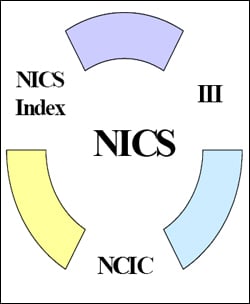 |
Tribal, local, state, and federal agencies voluntarily contribute information to the NICS Index, such as records exhibiting an illegal/unlawful alien status, or a disqualifying mental health history, among others. Maintaining such records in the NICS Index:
- provides an immediate indication to the user that the record, when validly matched to a prospective firearm transferee, has already been confirmed to be federally prohibiting; and
- often eliminates an otherwise lengthy review and evaluation process to determine the record’s prohibiting status and, ultimately, the subject’s firearms eligibility status.
With the implementation of the NICS in November 1998, the growth of the NICS Index was slow. Realizing the value of immediately prohibiting records during the background check process helps to mitigate the potential of prohibited persons receiving firearms, the NICS Section, throughout the past nine years, has continued to aggressively reach out to state and federal agencies seeking record information vital to the continued success of the NICS through means such as:
- committing resources devoted to outreach efforts (e.g., participation in various venues and forums, disseminations of NICS-specific information to numerous organizations and events, and mass mailings to state officials) in solicitation of record contributions;
- ongoing liaison with state officials regarding the benefits of submitting state-held information not available to the NICS (such as mental health information) that illustrates a federal firearms prohibition; and
- assisting the states in their efforts to implement, update, or amend legislation to allow for the dissemination of state-held information to the national database.
The promotion of the NICS Index has successfully increased the number of available federally prohibiting records maintained in the database. As of December 31, 2007, the majority of the states had initiated participation with the NICS Index (reference Figure 12), although many states, whether it be based on state policy or state privacy laws, are submitting on a limited basis.
Figure 12
NICS Index Participation as of December 31, 2007
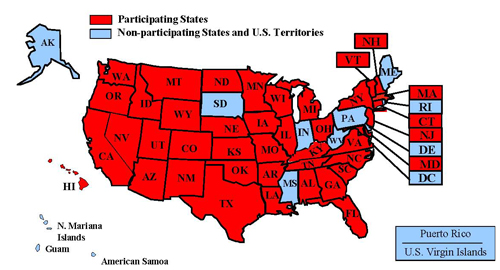 |
With increasing support and participation by state and federal agencies in contributing federally prohibiting records to NICS Index, the number of records maintained therein achieved a milestone in October 2007 with the contribution of the five millionth record. As of December 31, 2007, the NICS Index contained 5,108,039 records, an increase of approximately 24 percent above the number of records maintained year-end 2006, and an overall increase PTD of over 400 percent (reference Figure 13).
Figure 13
Growth of the NICS Index, All Categories
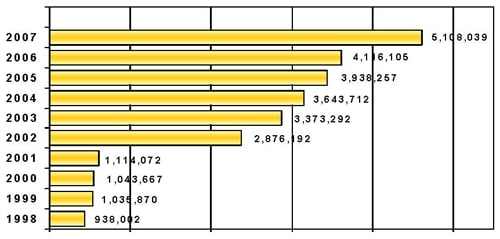 |
The NICS Index collects and maintains records specific to federally prohibited persons as outlined in the Brady Act. Each record in the NICS Index is categorized according to the federal prohibiting category upon which the record’s prohibiting status is predicated with the exception of the Denied Persons File (as explained below). Because the records maintained in the NICS Index are categorized, the NICS is able to generate various statistics for reporting and/or tracking purposes, determine what agencies are contributing what types of records and with what frequencies, and quickly pinpoint specific categories of records should a law or legal requirement change that, in turn, requires a review for applicability of all such records. The record files housing the NICS Index and the number of records maintained in each follows:
- Illegal/Unlawful Aliens: Persons who are aliens and are illegally/unlawfully in the United States. As of December 31, 2007, there were 3,851,155 illegal/unlawful alien records in the NICS Index.
- Mental Defective: Persons who have been adjudicated as a mental defective or have been involuntarily committed to a mental institution or have been deemed incompetent to handle their own affairs. As of December 31, 2007, there were 518,499 records based on a prohibiting mental health history maintained in the NICS Index.
- Denied Persons: Persons who are federally disqualified when a record is not already included in the III or the NCIC. The Denied Persons File may include any type of federally disqualifying information entered at the discretion of the originating agency, including prohibiting mental health information that cannot be labeled as such (e.g., by state law). It is undeterminable how many prohibiting mental health histories are included in the Denied Persons File. As of December 31, 2007, the Denied Persons File maintained 709,235 records.
- Dishonorable Discharge: Persons who have been discharged from the armed forces under dishonorable conditions. As of December 31, 2007, there were 15,345 records based on the existence of a dishonorable discharge.
- Citizenship Renunciant: Persons who have renounced their U.S. citizenship. As of December 31, 2007, there were 12,968 citizenship renunciation records maintained in the NICS Index.
- Controlled Substance Abuse: Persons who are an unlawful user of or addicted to any controlled substance. These types of records may or may not be maintained in other databases searched by the NICS and typically are subject to an expiration date. As of December 31, 2007, there were 837 controlled substance abuse records maintained in the NICS Index.
 |
NICS Index Focus - Mental Health Prohibitor
Throughout the last several years, various acts of gun violence have prompted lawmakers to reinforce the importance of stopping gun purchases by persons who are legally disqualified from purchasing/possessing them. In order for the NICS to be optimally effective in blocking the transfer of firearms to prohibited persons, information about individuals with firearms disqualifying mental health histories should be made available to the NICS.
One of the files comprising the NICS Index, the Mental Defective File, was created purposefully to gather and maintain records of persons who, pursuant to 18 U.S.C., §922 (g)(4), are prohibited from attaining firearms based on mental health reasons. All records in the NICS Index, including the Mental Defective File, are available to the state and federal agencies conducting NICS background checks. The information maintained in the NICS Index Mental Defective File is specific to persons who, by definition, have been adjudicated as a mental defective or have been involuntarily committed to a mental institution for treatment (reference the following definitions established in 27 C.F.R., § 478.11).
- Adjudicated as a mental defective:
(a) A determination by a court, board, commission, or other lawful authority that a person, as a result of marked subnormal intelligence, or mental illness, incompetency, condition, or disease;
- Is a danger to himself or to others, or
- Lacks the mental capacity to contract or manage his own affairs.
(b) The term shall include:
- A finding of insanity by a court in a criminal case; and
- Those persons found incompetent to stand trial or found not guilty by reason of lack of mental responsibility pursuant to articles 50a and 72b of the Uniform Code of Military Justice, 10 U.S.C., 850a, 876b).
- Committed to a mental institution:
A formal commitment of a person to a mental institution by a court, board, commission, or other lawful authority. The term includes a commitment to a mental institution involuntarily. The term includes commitment for mental defectiveness or mental illness. It also includes commitments for other reasons, such as for drug use. The term does not include a person in a mental institution for observation or a voluntary admission to a mental institution.
During the first years of NICS operations, less than 90,000 records were contained in the NICS Index’ Mental Defective File. Based on rapidly deployed efforts by the NICS Section to increase the overall number of records in the NICS Index, the number of mental health information submissions to the NICS Index increased dramatically in 2002 and has been on the rise since. Noting its largest annual increase since the NICS was implemented in November 1998, the NICS Index Mental Defective File reported an astounding overall 74 percent increase in record contributions in 2007 from the number reported in 2006 (reference Figure 14).
Figure 14
NICS Index Growth - Mental Health Information, November 30, 1998 through December 31, 2007
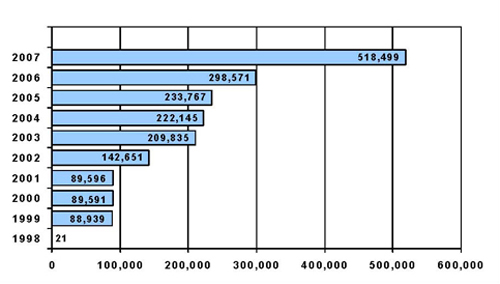 |
A closer look at the number of mental health records maintained in the NICS Index as of December 31, 2007, as compared to the corresponding number of those maintained as of year-end 2006, indicate the predominant increases in the number of records submitted to and maintained in the Mental Defective File were specific contributions by state agencies. As of December 31, 2007, the number of records submitted to the Mental Defective File by state agencies had increased approximately 152 percent from the number reported at year-end 2006.
Historically, in addition to conducting comprehensive outreach efforts, the NICS Section has tracked legislation pursued by numerous states seeking to share state-held prohibiting mental health information with the NICS. Whether the heightened number of record contributions were the result of the NICS Section’s ongoing outreach efforts or the consequences of current events and/or resulting initiatives or legislative changes, or a combination thereof, it is clear that the value of submitting federal firearms prohibiting record information to a national database has been acknowledged. For instance:
- At year-end 2006, the state of Ohio maintained one record in the Mental Defective File; however, in 2007, the number of record submissions to the Mental Defective File by Ohio agencies had increased to a total of 7,845.
- The state of California, as of year-end 2006, maintained 21 records in the Mental Defective File; however, in 2007, the number of record submissions to the Mental Defective File by California agencies had increased to a total of 203,103 records.
- The state of Florida began submitting records to the Mental Defective File in early 2007. As of December 31, 2007, Florida was maintaining 8,897 federally disqualifying mental health record submissions.
Availability of Federally Prohibiting Information Benefits All
When information specific to persons subject to a federal firearms prohibition is submitted to and maintained in a national database such as the NICS Index, the NICS Section or the POC state-designated agency can more effectively render accurate and timely background check determinations, both in the record’s state of origin and other states as well. Because today’s society is very transient, the availability of firearms prohibiting information beyond the boundaries of the record’s state of origin helps to mitigate the potential that persons who cross state lines in an attempt to receive a firearm will not succeed because the record is available at a national level. As of December 31, 2007, there have been 1,879 background check denials rendered to persons attempting to purchase a firearm outside the state that submitted the firearms prohibiting record to the NICS Index. This number represents an increase of approximately 28 percent over the number denoted for year-end 2006. Had these federally prohibiting records not been submitted to the NICS Index and made available during the background check process, firearms may have been transferred to disqualified persons. It is with successes such as these that the real value of the NICS Index in the pursuit of public safety and national security becomes evident.
NICS Improvement Amendments Act of 2007
On January 8, 2008, President George W. Bush signed into law the NICS Improvement Amendments Act of 2007 (NIAA), Public Law 110-180, passed by Congress on December 19, 2007. The NIAA amends the Brady Act and seeks to improve criminal history and Brady-prohibiting record reporting.
During a NICS background check, a search of a prospective firearm transferee’s name and descriptive information is conducted simultaneously through the records maintained in the III, the NCIC, and the NICS Index. When federal firearms-disqualifying information is not made available to the NICS, the potential that a prohibited person may be approved to receive a firearm becomes real and can lead to a tragedy.
Prior to the NIAA, state and federal agencies contributed records to the NICS Index on a voluntary basis. Even though the number of records maintained in the NICS Index has progressively increased over the last several years since the implementation of the NICS, it is evident that more firearms-prohibiting records must be made available to the NICS Index. The NIAA seeks to improve the quantity and quality of information available to the NICS by:
- requiring federal agencies to provide relevant information to the U.S. Attorney General (ergo the NICS) about specific categories of persons who are federally disqualified the transfer of a firearm pursuant to the Brady Act; and
- providing incentives to states and state court systems to submit complete information to the NICS on persons federally prohibited as well by authorizing new grant programs for state agencies to improve information sharing with the NICS, and by imposing penalties for states that do not comply with the NIAA’s record completeness goals.
The NIAA clearly defines the types of records that must be reported by the states and federal agencies to the NICS and is intended to mitigate the gaps in information that impede the NICS from realizing its full potential in identifying those persons prohibited by law from the receipt of firearms. As of December 31, 2007, the NICS Section had assembled a task force to assess the overall impact of the legislation both to the NICS Section and the POC state counterparts, and to reach out to tribal, local, state, and federal agencies in a nationwide information-sharing initiative.
6 Vol. 63, No. 210, Friday, October 30, 1998, Rules and Regulations.
7 Additionally, if the prospective firearms transferee is a non-U.S. citizen, a fourth search, via the databases of the ICE, is included.
Continuously faced with challenges associated with locating and obtaining record information needed to accurately and efficiently process background check transactions, the NICS Section continues its efforts to connect with law enforcement and judicial agencies on the importance of accurate and available criminal history and Brady-prohibiting information, e.g., final dispositions, disqualifying mental health adjudications, etc. Aware that incomplete or unavailable criminal history records (CHRs) serve to negate the effectiveness of law enforcement and criminal justice efforts at many levels, the NICS Section continues to foster a comprehensive outreach program.
Central to the NICS Section’s outreach efforts is the NICS State Support Team. The personnel staffing the NICS State Support Team identify, develop, and make available various training and information-sharing regimens to the NICS’ users and numerous law enforcement, judicial, and criminal justice agencies. Offering a catalogue of comprehensive training services specific to topics such as the firearm background check and related processes, the Brady Act and the GCA, the interpretation and application of federal prohibiting criteria, the challenges of effectively and efficiently determining if state laws are firearms prohibiting, the NICS appeal process, etc., the NICS State Support Team, in 2007, traveled to 43 cities in 21 states providing 58 training sessions to almost 2,000 professionals, such as intelligence analysts, records clerks, special agents, computer information specialists, law enforcement officers and technicians, criminal justice training specialists, firearm permit technicians, court clerks, and judges. Receiving numerous accolades for their service to the law enforcement and judicial community, it is apparent that NICS Section’s outreach efforts are impacting the effective and efficient processing of background checks via the NICS.
The NICS Section also shares information in a variety of other means, such as via:
- Law Enforcement Online (LEO): Managed by the FBI through the Internet, LEO electronically connects various levels of law enforcement via a secure network;
- NICS website at www.fbi.gov/hq/cjisd/nics/index.htm: The NICS website makes available information, such as state and federal statutes/legislation, guidance in legal interpretation and applicability, the NICS Regulations, etc., to all interested persons including the general public;
- NICS Newsletters: Disseminated periodically by the NICS Section, NICS Newsletters share information with NICS’ partners relating to a wide variety of topics, e.g., system and operational changes, and legislative changes or updates;
- NICS Fax-on-Demand: Utilizing a telephone dial-up access, this feature allows an individual to call an automated system and request specific NICS information, such as FFL Enrollment Forms and various NICS brochures; and
- Mass Mailings to the users of the NICS, e.g., FFLs, and state POC and Partial-POC agencies.
The NICS Section fosters working relationships with numerous nationwide initiatives. The following information outlines some of the highlights of the NICS Section’s outreach efforts in 2007.
- Shooting, Hunting, Outdoor Trade (SHOT) Show, January 2007: Providing information-sharing opportunities to over 42,000 participants at the annual SHOT Show, an event that unites firearms manufacturers, retailers, and other industry stakeholders, the NICS Section staff facilitated approximately 300 live NICS E-Check demonstrations, participated in panel discussions with the ATF, and distributed sample VAF packets.
- National Rifle Association Conference, April 2007: The NICS Section and the ATF partnered to address inquiries and concerns expressed by attendees specific to the NICS background check process and gun control laws.
- NICS User Conference, May 2007: Gathering in Tigard, Oregon, the NICS Section sponsored its annual information-sharing forum connecting state and federal agencies together for the purpose of sharing ideas and discussing topics of mutual interest and concern, such as impending and anticipated system and operational upgrades. Participants included the NICS Section, CJIS Division officials, POC/Partial-POC states, the ATF, the ICE, the DOJ/BJS and numerous other state and federal agencies.
- CJIS Overview Conference, August 2007: The NICS Section, in concert with the CJIS Division, provided information-sharing opportunities to law enforcement agencies across America regarding the NICS and the value of complete criminal history information.
- Report, Educate, Associate Criminal Histories (REACH) Conference, September 2007: The NICS Section sponsored and co-hosted its second annual REACH conference at the CJIS Division in Clarksburg, West Virginia. The REACH initiative seeks to connect with administrative officials of states whose disposition-reporting practices could more immediately benefit from the comprehensive sharing of information aimed at resolving obstacles faced by the states specific to the effective and efficient reporting of disposition information to the FBI. With 26 attendees representing 9 states, the conference focused on information-sharing topics conducive to effective and efficient criminal history records maintenance and the value of making disposition information available to the NICS.
- Project Safe Neighborhoods (PSN) Conference, September 2007: Meeting in Atlanta, Georgia, representatives from the NICS Section participated with the DOJ’s PSN initiative by providing numerous information-sharing opportunities specific to the NICS processes and the value of available criminal history and related records to the NICS and law enforcement agencies.
- Court Technology Conference (CTC), October 2007: Representatives from the NICS Section participated, for the first time, in the CTC held in Tampa, Florida. The CTC, hosted by the National Center for State Courts, connects more than 2,500 court professionals around the world to discuss matters regarding the sharing of criminal history information.
Criminal History Dispositions
When a final background check status of proceed or deny cannot be provided during an FFL’s initial contact with the NICS, the transaction is placed in a delay status, and the NICS Section immediately reaches out to law enforcement and/or judicial agencies in an attempt to obtain the needed record information, usually final dispositions. Pursuant to the Brady Act, the NICS is afforded three business days with which to obtain the needed information and render a final transaction determination. If a definitive proceed or deny decision cannot be rendered prior to the lapse of three business days, the FFL can legally transfer the firearm; however, in support of the NICS mission, and in the furtherance of public safety and national security, the NICS Section continues outreach efforts for a much longer period of time.
In 2007, approximately 37,350 dispositions received by the NICS Section staff were posted to CHRs. Over 630,000 dispositions have been posted to CHRs as a result of NICS Section efforts. Additionally, 14,688 dispositions obtained by the NICS Section employees were also shared with the states for use and maintenance at the state level as well.
Misdemeanor Crime of Domestic Violence (MCDV) Processing
The NICS has been providing FFLs with background check determinations on potential gun buyers since its implementation on November 30, 1998. As with any program, adjustments in process or policy are often necessary not only to improve the program but to maintain the level of confidence its users and stakeholders have in the program. One such adjustment specific to “how the NICS program determines whether the requisite element of force that would prohibit an individual from purchasing a firearm is met within an MCDV conviction” was comprehensively reviewed in-depth by the DOJ. As a result, adjustments regarding the applicability of the element of force when determining the existence of a qualifying MCDV were effected in August 2007.
The GCA, as referenced in 18 U.S.C., §922 (g)(9) and §925 (a)(1), prohibits persons who have been convicted of an MCDV from receiving or possessing a firearm. A qualifying MCDV, pursuant to 18 U.S.C. §921 (a)(33), is an offense that:
- is a misdemeanor under tribal, local, state, or federal law;
- has, as an element, the use or attempted use of physical force, or the threatened use of a deadly weapon; and
- was committed by a current or former spouse, parent, or guardian of the victim; by a person with whom the victim shares a child in common; by a person who is cohabiting with or has cohabited with the victim as a spouse, parent, or guardian; or by a person similarly situated to a spouse, parent or guardian of the victim.
The myriad of offenses that could constitute MCDVs include all misdemeanor offenses that contain either the use of physical force, the attempted use of physical force, or the threatened use of a deadly weapon as an element, so long as the offense is committed against a person with whom the defendant had a “qualifying” relationship (described above).
Many misdemeanor offenses that could qualify as an MCDV have multiple subsections of the statute. Some of the subsections contain the element of force, and some do not. For example, a generic assault statute may provide that a person commits an assault either by (1) using physical force against another person or (2) by verbally threatening another person. Assuming the requisite domestic relationship is present, a conviction under the first part of the statute would satisfy the MCDV definition, while a conviction under the second part would not.
Few MCDVs are labeled as such. For example, if the NICS identifies a misdemeanor conviction under a statute that can only be violated by the use or attempted use of physical force or the threatened use of a deadly weapon, the NICS can deny the firearm transfer after establishing the necessary domestic relationship. If, however, the NICS identifies a misdemeanor conviction under a statute with multiple subparts, where only some of those elements require the use or attempted use of physical force or the threatened use of a deadly weapon, but the particular subpart is not specified in the record, further research is required. Once the NICS determines a qualifying relationship, which is typically accomplished by reference to a police report, the NICS then seeks information to determine whether the individual was convicted under the part of the statute requiring the use or attempted use of physical force.
Prior to August 2007, the NICS Section and the POC states used police reports not only to establish the relationship between the victim and the offender in an MCDV, but also to determine the element of force. However, as a result of the aforementioned review, the NICS Section and the POC states must now request the record of conviction to determine if force was attempted, threatened, or used in instances where an offense has multiple subparts not all of which would satisfy the element of use or attempted use of force or the threatened use of a deadly weapon and when the specific subsection of the conviction is not present as part of the record. In other words, reference to a police report can establish an MCDV-qualifying relationship, but it cannot be used to establish the element of force unless the police report is referred to in the record of conviction documents.
If the record of conviction is not explicit enough, the NICS Section or the POC state agency performing the research must request a copy of the court transcripts or other such supporting court documents in order to determine if the misdemeanor conviction qualifies as an MCDV pursuant to the GCA. However, this has proven to be a challenge as oftentimes local courts destroy misdemeanor court records within a few years of the completion of the case. Also, court records for these cases may be less explicit than records for more serious offenses and may not indicate the offender’s relationship to the victim. Because these documents are vital to the NICS program’s ability to effectively determine the existence of an MCDV, the NICS Section is working with the state courts for their assistance with:
- providing prompt responses to NICS requests for information specific to MCDVs;
- ensuring in cases in which misdemeanors involve multiple subparts, the court records list the exact statutory subsection predicating the conviction, and the charging papers or record of conviction describes any use or attempted use of physical force or threatened use of a deadly weapon; and
- ensuring the above information is included when disposition information is submitted to state agencies maintaining automated criminal history databases that are part of the computerized information system searched during a NICS background check.
Making the above information available to the NICS will lessen the potential that a firearm will be transferred to a prohibited person or a lawful transaction will be delayed, sometimes indefinitely, because of the need to conduct further research and attempt to obtain transaction supporting record information.
FBI’S MAJOR CASE CONTACT CENTER (MC3)
In September 2005, the FBI’s envisioned national networked integrated contact center became a reality with the activation of a tip line to receive and document alleged incidents of fraud associated with Hurricane Katrina. For over two years, the NICS Section, with several years of experience in managing a national call center-based operation, has continued the development of the FBI’s MC3. The FBI’s MC3 supports optimal communications between the criminal justice community and the general public specific to the sharing of information related to major case investigations, special events, regional or national events and/or catastrophic incidents, or instances where heightened communications are crucial to personal well-being.
The MC3 can support multiple simultaneous critical incidents or major case investigations. Activations of the MC3 are at the direction of FBI Executive Management. Through the use of a toll-free telephone line, the exchange of information from the public to the MC3 via the NICS Section is accomplished by dialing 1-800-CALL FBI. As of December 31, 2007, a total of 13 MC3 activations had been accomplished. Five of the 13 activations (listed below) occurred in 2007:
- Child Abduction - Wheeling, West Virginia: Active from February 23, 2007, to March 23, 2007.
- Multiple incidents of Abduction and Sexual Assault, Cold Case - Hagerstown, Maryland: Active from May 8, 2007, to May 15, 2007.
- James “Whitey” Bulger - One of the FBI’s Ten Most Wanted Fugitives: Active from September 13, 2007, to October 12, 2007. This activation of the MC3 also utilized a toll-free international line as well.
- Southern California Wildfires: Active from October 24, 2007, to October 30, 2007.
- Child Abduction - North Wheeling, West Virginia/Sexual Assault Case, Kentucky: Active from October 31, 2007, to November 13, 2007.
In 2007, to enhance the FBI’s capability to account for personnel during disasters, the MC3 was designated as the alternate means for FBI employees to report personnel status during or after a crisis event. Previously, during a crisis event, accountability was established via an FBI employees’ direct contact with a supervisor. However, the FBI realized that providing an alternate means for establishing employee accountability, e.g., from areas outside of the affected region(s), could mitigate potential inefficiencies and loss of information. When activated to collect information specific to personnel accountability, the MC3 will provide a centralized source for all FBI employees and contractors to contact to establish accountability as an alternative to an employee’s direct contact with a supervisor.
07.09.10
General Information
- Fact Sheet
- Index Brochure (pdf)
- Overview Brochure (pdf)
- Participation Map
Appeals
- Appeals/Voluntary Appeal File Process
- Frequently Asked Questions
- Guide to Appeals Brochure - English (pdf) | Español (pdf)
- Voluntary Appeal File Brochure - in English (pdf) | Español (pdf)
- Standard Fingerprint Form (pdf)
- Attorney Release Form (pdf)
Videos

|
 |
|
NICS Voluntary Appeal File (VAF) |
NICS Process (for Customers) |

|

|
| NICS E-Check |
NICS Process (for Dealers) |
Resources For Federal Firearms Licensees
Reports and Statistics
- Operations Reports: 2014 (pdf) | 2013 | 2012 | 2011 (pdf) |
2010 (pdf) | 2009 | 2008 | 2007 | 2006 | 2005 | 2003/2004 |
2001/2002 | 2000 (pdf) | 1998/1999 (pdf)
- Active Records in the NICS Index (pdf)
- Active Records in the NICS Index by State (pdf) | Press release
- Federal Denials (pdf)
- NICS Firearm Checks: Month/Year (pdf)
- NICS Firearm Checks: Month/Year by State (pdf)
- NICS Firearm Checks: Month/Year by State/Type (pdf)
- NICS Firearm Checks: Year by State/Type (pdf)
- NICS Firearm Checks: Top 10 Highest Days/Weeks (pdf)
News and Stories
- 2013: NICS Turns 15
- 2011 Testimony
- 10th Anniversary Story | Speech | Photos

